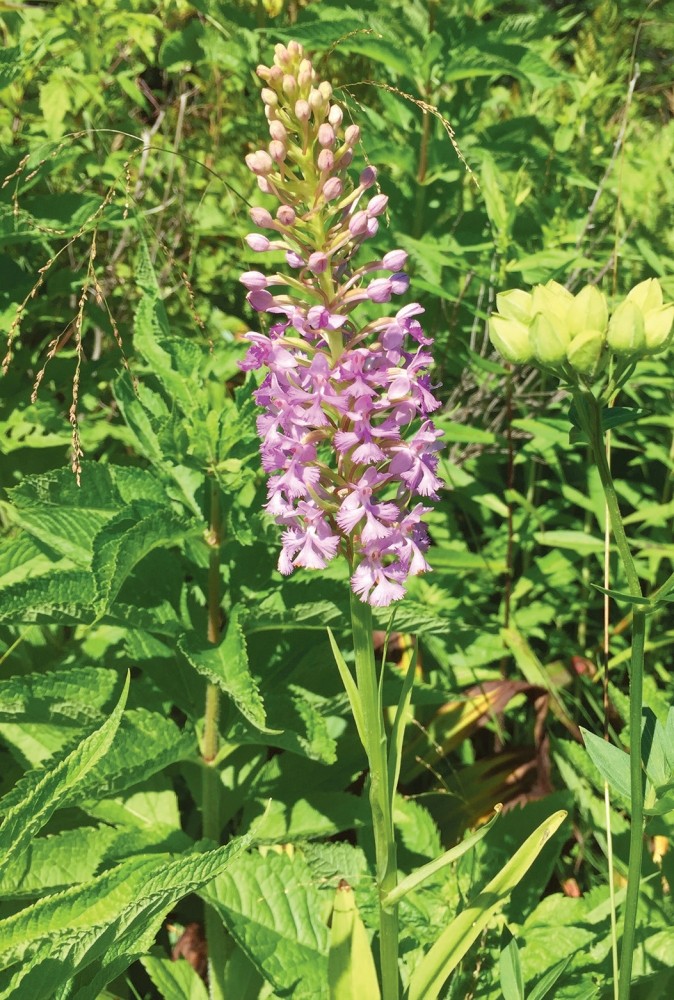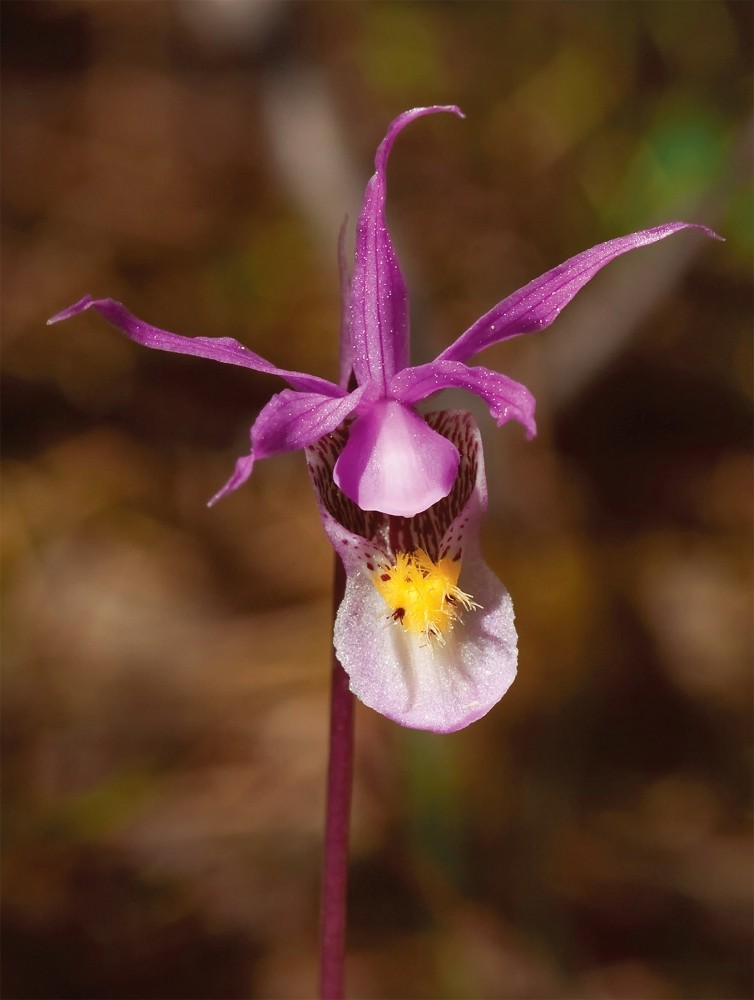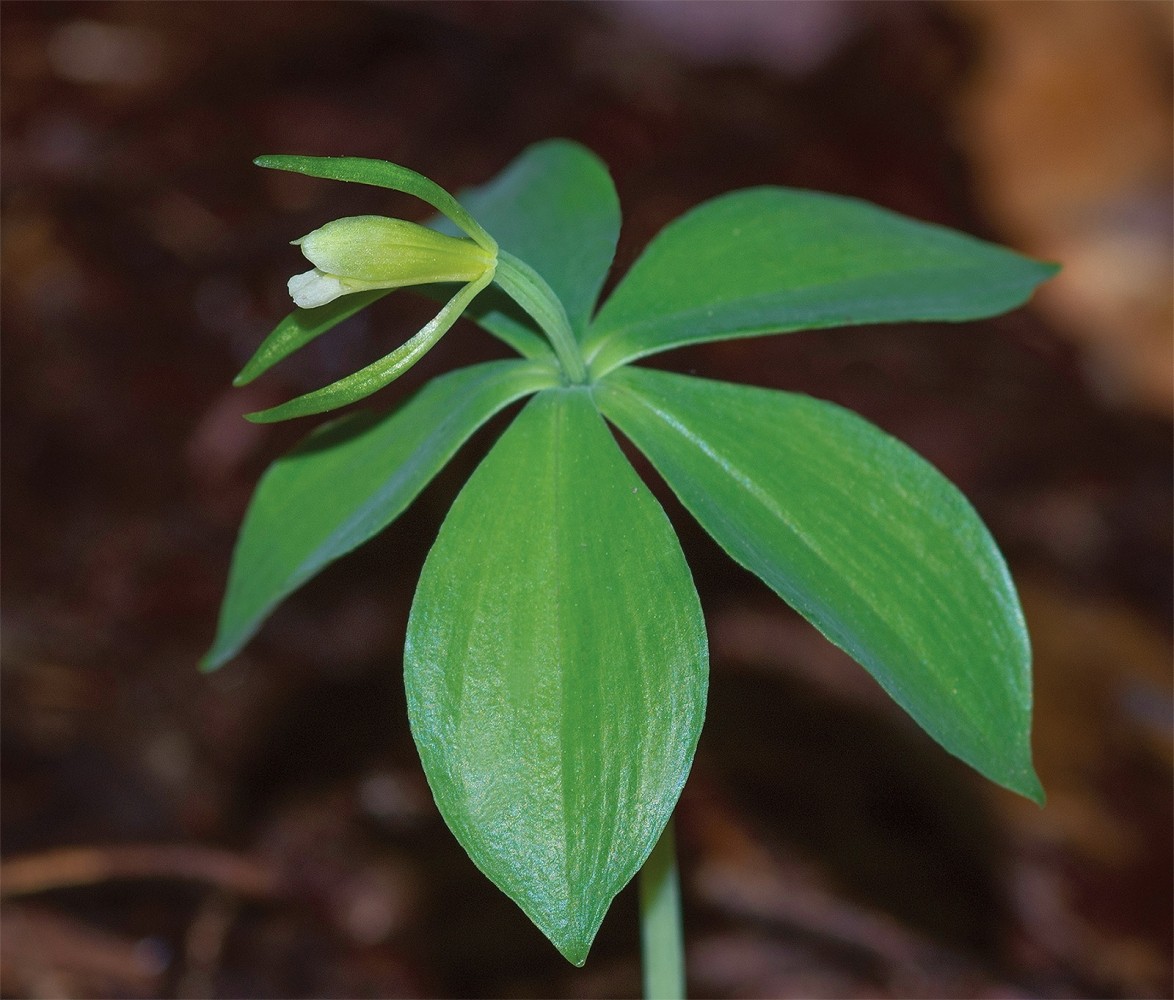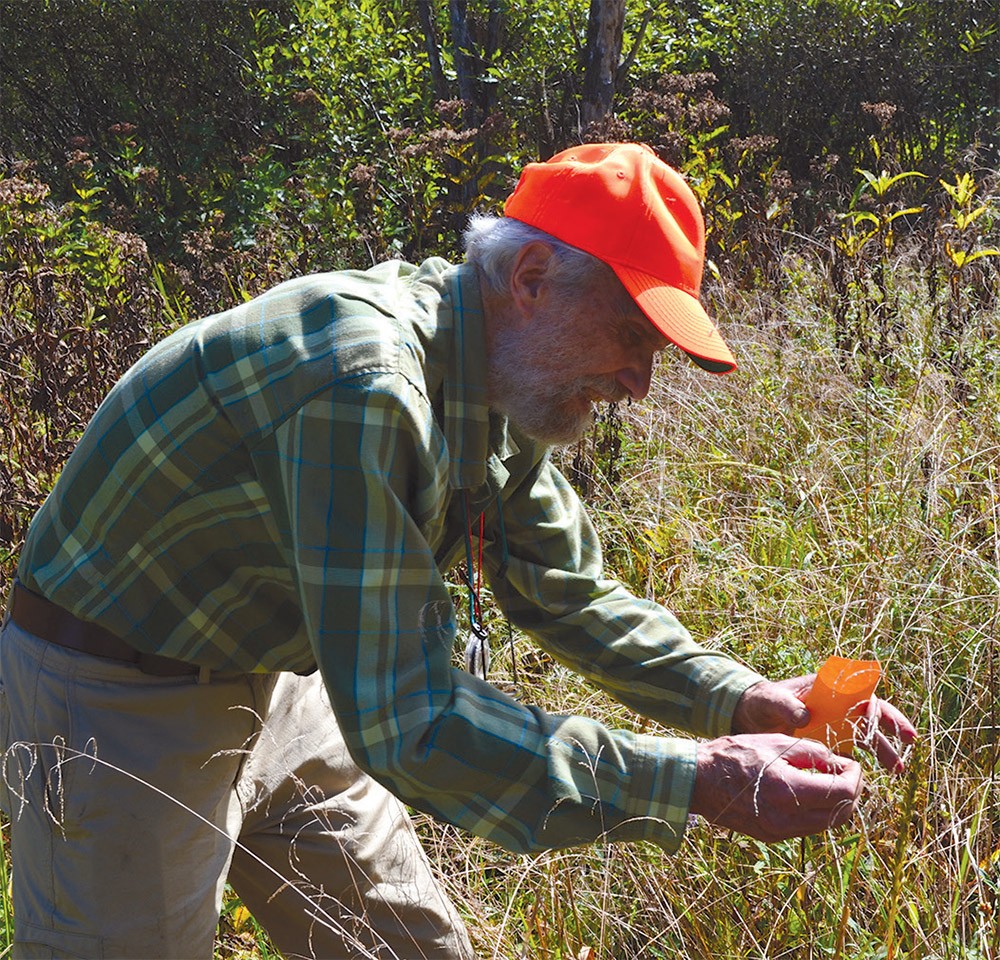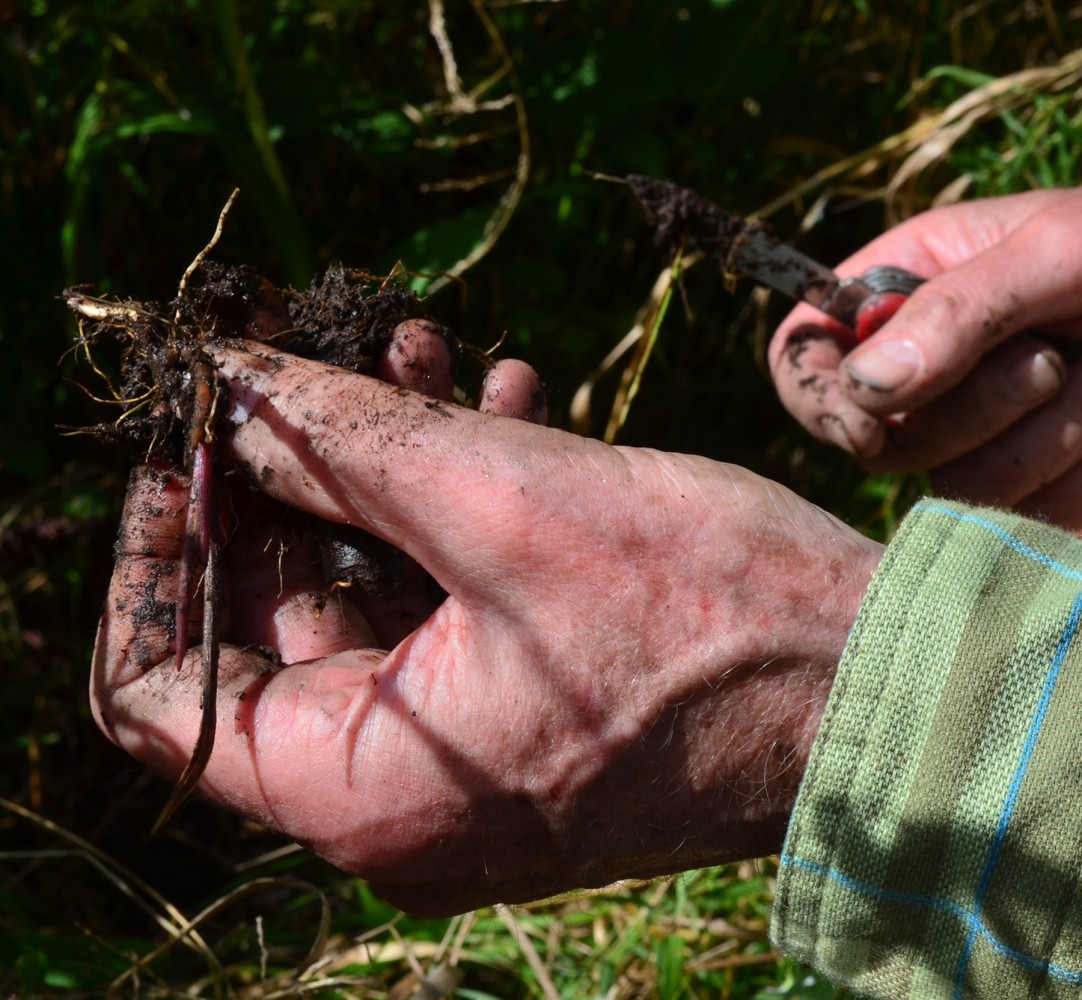
After climbing a steep, winding road through a gap in Vermont’s Green Mountains, my car descended into Addison County, rolling past fields bright with purple aster and goldenrod. A black Subaru wagon was parked at a pre-arranged meeting spot at a junction of dirt roads. Out stepped Warren King, a spry, gray-bearded, retired ornithologist, environmental educator, and long-time conservationist who now spends significant time volunteering for the New England Wild Flower Society. This particular day, King was working on the Common Orchid Project, a collaboration between the New England Wild Flower Society and the North American Orchid Conservation Center, a program of the Smithsonian Environmental Research Center. He led me through a maze of dirt roads and we parked, pulled on tall rubber boots, and shouldered our day packs. Crossing the road, we bushwhacked through dense woods, part of the Green Mountain National Forest.
In a couple of hundred yards, we emerged into an open wetland that featured scattered clumps of alder and willow shrubs. Earlier in the summer, King and other volunteers had been here to monitor a rare plant as part of their work for the New England Wild Flower Society. On that visit, King had also spotted some 200 lesser purple fringed bog orchids (Platanthera psycodes) in bloom, their stunning fringed flowers ranging from pale lilac to rosy magenta. In Our Wild Orchids (1929), naturalists Morris and Eames describe this flower’s blossoms: “Clustered like a swarm of butterflies with fretted wings of mauve, they make a dainty show on their leafy perch.” We were here to collect samples from a few of these orchids for the Orchid Project, whose goal is to better understand native orchids in order to conserve and propagate them. The North American Orchid Conservation Center collects seeds, leaves, and root pieces from all North American orchid species in each ecoregion (an area containing a geographically distinct assemblage of species, natural communities, and environmental conditions; Vermont, the Berkshires, the Adirondacks, most of New Hampshire, and the western half of Maine are in the Northeastern Highlands Ecoregion). This nationwide project currently has more than 50 collaborators; the New England Wild Flower Society is coordinating the collections in New England. The work started with common orchids, such as the lesser purple fringed orchid, so methods can be refined if necessary before collecting samples from rare orchids. (As orchids go, the purple fringed orchid is considered common, but it requires a special habitat and is not a plant you’re likely to find in your backyard.)
Threatened Beauties
The mainland US and Canada are home to 210 species of orchids; between 55 and 60 percent of them are threatened, endangered, or have disappeared from at least part of their range, according to Dennis Whigham, a plant ecologist and founding director of the North American Orchid Conservation Center. Many orchid species that were once widespread are now found only in small, fragmented populations. These range from the extremely rare calypso or fairy slipper (Calypso bulbosa), whose deep pink or lavender pouches with yellow-bearded aprons dangling from long stalks enliven dark coniferous swamps in Vermont and Maine, to the rare orange fringed bog orchid (Platanthera ciliaris), whose showy plumes glow in damp meadows and thickets in Connecticut and Rhode Island. Orchids have declined due to development, forestland succession, and other changes to their habitat, overbrowsing by deer, and perhaps climate change, according to Bill Brumback, conservation director at the New England Wild Flower Society.
Another factor that contributed to their decline was the excessive nitrogen emissions from vehicles and power plants that occurred before the Clean Air Act of 1998. Nitrogen is a plant nutrient used in fertilizers, but orchids are specially adapted to low-nutrient environments. As nitrogen levels in the soil rose in the twentieth century, so did the orchid’s competition. Thanks to the Clean Air Act, nitrogen emissions have decreased by 50 percent since the 1980s, and researchers are interested in seeing how orchids respond as the land continues to recover.
Orchid poaching is a problem worldwide, and many orchids, including all of our North American orchids, are protected from international trade by the Convention on International Trade in Endangered Species of Wild Flora and Fauna (CITES). Despite this treaty, there is a booming illicit trade in tropical wild orchids. Although the extent of poaching in New England is unknown, Brumback doesn’t believe it is a major factor in orchid decline in our region; habitat destruction and natural succession (some orchids need more sun and are shaded out as a forest matures) are more to blame. But since collection is a potential threat, conservation organizations tend to keep rare orchid locations secret.
A Unique Biology
Unlike the tropical orchids sold as houseplants, only a few native orchids have been successfully grown in the lab or in nurseries, so it is difficult to propagate them for restoration projects. Orchids are challenging to grow because of their relationship with underground fungi, either free-living in the soil or attached to the roots of nearby trees or plants. The tiny, dust-like orchid seeds have no stored starch reserves and need nutrients from the fungi to germinate. The seeds first develop into tuber-like protocorms that remain belowground for a few years. During this stage, they obtain all their nutrients from mycorrhizal fungi. As the seedlings emerge, produce leaves, and begin to photosynthesize, they depend less on fungi, but continue to use them to supplement their nutrition, especially under stressful environmental conditions. If the specific fungus an orchid needs is absent, it won’t survive. As adults, orchids depend on underground fungi when they undergo periods of dormancy. (Some years, orchids don’t make an appearance above ground, but their roots remain active.) Since the fungi do not appear to be benefitting from this relationship with orchids, it is considered a parasitic rather than a symbiotic relationship. One of the goals of the Orchid Project is to identify which fungus or fungi each orchid species relies on.
Orchids are renowned for their wide range of pollination mechanisms, and the resulting diversity of flower types. Many orchids attract pollinators by deception. For example, the pink lady’s slipper (Cypripedium acaule), common in the Northeast, lures bumblebees inside with its color and fragrance, but offers no nectar in return. Its flower functions like a lobster trap: easy to enter, but difficult to exit. In order to leave the lady’s slipper’s pouch, bees must pass the stigma (female part) and rub off any pollen they are carrying, as well as the flower’s anther (male part), which smears pollen onto the bee’s back. Some orchid flowers are designed to attract specific species of bees, moths, or butterflies. If these pollinators become scarce or climate change disturbs the synchrony between their activity and orchid flowering, the plants will not set seed. Other orchids are self-pollinating, apparently having evolved to produce seed in the absence of pollinators.
Getting Muddy for Science
Back in the Vermont wetland, we searched for the lesser purple fringed bog orchids that Warren King had seen a month earlier.
They were harder to find now that it was September, as the plants had finished blooming and their leaves had begun to dry up. But soon King spotted a tall, greenish-yellow stalk topped with a spike of green fruits containing seeds. He measured the orchid at 40 inches high and took a GPS reading of its location. Next, he carefully cut half a leaf from the plant and placed it into a paper coffee filter to dry. He removed two seed capsules and put them into a coin envelope. (Our instructions were not to collect more than 10 percent of the seed.) King then dug around the base of the plant with his pocketknife, searching for the roots. “The soil is good and wet, as you’d expect,” he commented, examining a handful of brown muck. About two inches below the surface, King found the roots of the orchid. He cut a few and placed them in plastic bags with a damp paper towel to keep them moist. Each bag and envelope was carefully labelled according to North American Orchid Conservation Center’s specimen-tracking protocol.
As the sun beat down on us, we walked slowly through the wetland, our boots squishing in the mud. We found nine more purple fringed orchids scattered through the tall grass and collected more seed capsules. When he returned home, King packaged the root samples and sent them priority mail to the Smithsonian Environmental Research Center while they were still fresh. He let the leaf and seeds air dry. Later, he sent the leaf to the North American Orchid Conservation Center and the seeds to the New England Wild Flower Society’s Nasami Farm in Deerfield, Massachusetts, to be prepared for long-term storage.
At the Smithsonian Environmental Research Center’s lab in Maryland, a technician cleaned the orchid roots and examined them under a dissecting microscope. Dennis Whigham and his associates checked the root cells for mycorrhizal fungi. They extracted the tiny balls of fungus with a glass needle and placed them onto agar (a medium made from algae that provides nutrients). Once the fungus grows enough so the thread-like fungal hyphae are visible, it will be stored in a glass tube with low-nutrient agar. The tube will be kept at room temperature and checked every six months to ensure the fungi are still alive. In this way, the organization is creating a living “fungal bank” of orchid fungi; it now has 800 to 900 specimens, the largest such collection in the world. Whigham hopes to eventually have 10,000 specimens, and is investigating whether they can be stored more efficiently in liquid nitrogen. Many of these mycorrhizal fungi are new to science. Melissa McCormick, a research scientist, will process them in her molecular lab to determine their DNA sequence, and share that with other researchers via the Internet.
The dried leaf sample King sent will be stored at room temperature or in a freezer. Whigham plans to use molecular techniques to compare the DNA of leaves from different populations of the same species to learn about genetic diversity within an orchid species. The seeds King collected will be added to the New England Wild Flower Society’s regional seed bank at its headquarters in Framingham, Massachusetts, a freezer maintained at 25 to 35 percent humidity. Although seeds of other plants have been stored for 50 to 100 years this way, preserving tiny, fragile orchid seeds is more challenging. The North American Orchid Conservation Center and its collaborators are working to find best practices for seed storage by conducting germination and propagation trials under different conditions; they’ll ultimately establish seed banks for orchids around the country. In a hopeful development, Rach Helmich, a student at Illinois College working with Professor Lawrence Zettler, recently paired orchid seeds and mycorrhizal fungi, both stored for 28 years. She successfully germinated the white fringeless orchid (Platanthera integrilabia), a federally threatened orchid native to the Southeast.
Future Restoration
Of the 56 native species of orchids in New England, 26 are listed as rare, threatened, or endangered regionally or globally, and most of the others are considered rare in at least one state.
Since the North American Orchid Conservation Center’s ambitious project is still in the early stages, it’s hard to discuss specific restoration plans, said Bill Brumback. But until native orchids can be grown for restoration projects, habitats can be managed to encourage orchids. “Many orchids are more early successional than we’ve realized,” he explained, and need more sun. The New England Wild Flower Society has been successful in increasing populations of the small whorled pogonia (Isotria medeoloides), a globally rare orchid revered by orchid enthusiasts. Most of the world’s population grows in the thick leaf litter of mixed deciduous and coniferous forests in Maine and New Hampshire. An unusual-looking plant, one or two greenish-yellow flowers rise above a whorl of five leaves attached at the same point on the stem. By careful thinning of the forest canopy in the winter when the ground was frozen, researchers doubled the amount of light reaching the ground at their experimental site, and the number of orchids and their subsequent reproductive success both increased. This strategy is now being used at other sites where this orchid grows.
Another good candidate for this type of habitat manipulation is the ram’s head lady’s slipper (Cypripedium arietinum), according to Brumback, with its white conical pouch veined with crimson. Selectively thinning the northern white cedar swamps where it grows could benefit the plant, though he cautions that trying to reverse succession is always a risk, as more sun can also allow invasive plants to get a foothold.
Once they can be grown in a nursery, Brumback says his first priority would be to restore New England orchids that are globally imperiled, such as the eastern prairie fringed orchid (Platanthera leucophaea), with its large, creamy white flowers. Currently, there is only one population of this plant in our region – in a fen in northern Maine. Of course, their mycorrhizal fungi will also need to be introduced to any new site. Bayard’s adder’s mouth (Malaxis bayardii), a small, inconspicuous orchid with a spike of tiny green flowers that grows in dry sandy fields and heaths in southern New England, would be another good choice for immediate attention.
The Value of Orchids
Why go to all this trouble to save native orchids when we can buy lovely tropical orchids in the supermarket? “Orchids have no more intrinsic value than a rare sedge, but they attract attention to rare plants in general,” said Brumback. “And we don’t yet understand the role of all these species in pulling our ecosystems together.” Aaron Marcus, assistant botanist with the Vermont Department of Fish and Wildlife, points out that because, “Ecosystems are very complex and interconnected, we don’t know what we’re losing when we lose these species… Biodiversity is going to be very important in the resilience of our ecosystems to climate change and to human survival.” Native orchids are also part of our region’s natural heritage.
After collecting the orchid samples, Warren King and I sat under a tree in the adjacent forest, eating our lunches. He told me that he volunteers to do this type of work for one simple reason: “I find it fascinating. A lot of questions come up, and occasionally you provide an answer.” With the help of King and other dedicated volunteers, researchers are gradually revealing the secrets of wild orchids.
A Comprehensive Effort to Save Orchids
The North American Orchid Conservation Center was established in 2012 and is housed at the Smithsonian Environmental Research Center headquarters in Edgewater, Maryland. In the past, most research and propagation efforts in the US and Canada have focused on tropical orchids. The Orchid Center’s goals include supporting research on native orchids (both terrestrial and tree-growing epiphytic orchids), fostering efforts to preserve orchid habitats; developing procedures for propagating orchids in the lab, greenhouse, and garden; and education. They’ve developed a website called Go Orchids (modeled after the New England Wild Flower Society’s Go Botany), which provides extensive information and photos of orchids. To raise awareness, they have created 3-D flower models that children and parents can put together, called “orchid-gami” – “a nice way to blend art and science to make orchids accessible to the public,” said Julianne McGuinness, program development coordinator with the North American Orchid Conservation Center. (These can be downloaded from the group’s website.) The organization’s long-term goals are to work with groups to take orchid seeds and fungi that have been stored and grow native orchids. Whigham envisions educational displays and living collections of orchids and mycorrhizal fungi at botanical gardens. Information could be provided to citizen scientists interested in growing orchids in their backyards; natural dispersal from these sources could one day put more native orchids back into the landscape.


